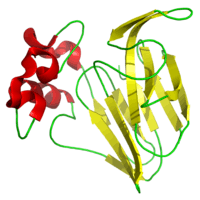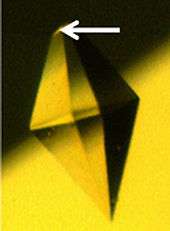Thaumatin
Thaumatin (also known as talin) is a low-calorie sweetener and flavour modifier. The protein is often used primarily for its flavour-modifying properties and not exclusively as a sweetener.[3]
| Thaumatin family | |||||||||
|---|---|---|---|---|---|---|---|---|---|
 | |||||||||
| Identifiers | |||||||||
| Symbol | Thaumatin | ||||||||
| Pfam | PF00314 | ||||||||
| InterPro | IPR001938 | ||||||||
| SMART | SM00205 | ||||||||
| PROSITE | PDOC00286 | ||||||||
| SCOPe | 1thu / SUPFAM | ||||||||
| OPM superfamily | 168 | ||||||||
| OPM protein | 1aun | ||||||||
| CDD | cd09215 | ||||||||
| Membranome | 1336 | ||||||||
| |||||||||
| Thaumatin I | |||||||
|---|---|---|---|---|---|---|---|
| Identifiers | |||||||
| Organism | |||||||
| Symbol | Thm1 | ||||||
| PDB | 1RQW | ||||||
| UniProt | P02883 | ||||||
| |||||||
| Thaumatin II | |||||||
|---|---|---|---|---|---|---|---|
| Identifiers | |||||||
| Organism | |||||||
| Symbol | Thm2 | ||||||
| PDB | 3wou | ||||||
| UniProt | P02884 | ||||||
| |||||||
The thaumatins were first found as a mixture of proteins isolated from the katemfe fruit (Thaumatococcus daniellii Bennett) (marantaceae) of west Africa. Some proteins in the thaumatin family of sweeteners are roughly 2000 times more potent than sugar. Although very sweet, thaumatin's taste is markedly different from sugar's. The sweetness of thaumatin builds very slowly. Perception lasts a long time, leaving a liquorice-like aftertaste at high usage levels. Thaumatin is highly water-soluble, stable to heating, and stable under acidic conditions.
Biological role
Thaumatin production is induced in katemfe in response to an attack upon the plant by viroid pathogens. Several members of the thaumatin protein family display significant in vitro inhibition of hyphal growth and sporulation by various fungi. The thaumatin protein is considered a prototype for a pathogen-response protein domain. This thaumatin domain has been found in species as diverse as rice and Caenorhabditis elegans. Thaumatins are pathogenesis-related (PR) proteins, which are induced by various agents ranging from ethylene to pathogens, and are structurally diverse and ubiquitous in plants:[4] They include thaumatin, osmotin, tobacco major and minor PR proteins, alpha-amylase/trypsin inhibitor, and P21 and PWIR2 soybean and wheat leaf proteins. The proteins are involved in systematically acquired resistance and stress response in plants, although their precise role is unknown.[4] Thaumatin is an intensely sweet-tasting protein (on a molar basis about 100,000 times as sweet as sucrose[5]) found in the West African shrub Thaumatococcus daniellii: it is induced by attack by viroids, which are single-stranded unencapsulated RNA molecules that do not code for protein. The thaumatin protein I consists of a single polypeptide chain of 207 residues.
Like other PR proteins, thaumatin is predicted to have a mainly beta structure, with a high content of beta-turns and little helix.[4] Tobacco cells exposed to gradually increased salt concentrations develop a greatly increased tolerance to salt, due to the expression of osmotin,[6] a member of the PR protein family. Wheat plants attacked by barley powdery mildew express a PR protein (PWIR2), which results in resistance against that infection.[7] The similarity between this PR protein and other PR proteins to the maize alpha-amylase/trypsin inhibitor has suggested PR proteins may act as some form of inhibitor.[7]

Within West Africa, the katemfe fruit has been locally cultivated and used to flavour foods and beverages for some time. The fruit's seeds are encased in a membranous sac, or aril, that is the source of thaumatin. In the 1970s, Tate and Lyle began extracting thaumatin from the fruit. In 1990, researchers at Unilever reported the isolation and sequencing of the two principal proteins found in thaumatin, which they dubbed thaumatin I and thaumatin II. These researchers were also able to express thaumatin in genetically engineered bacteria.
Thaumatin has been approved as a sweetener in the European Union (E957), Israel, and Japan. In the United States, it is generally recognized as safe as a flavouring agent (FEMA GRAS 3732) but not as a sweetener.
The thaumatin-like proteins isolated from kiwi fruit or apple appear to have their allergenic properties minimally reduced by gastroduodenal digestive processes, but not by heating.[9][10]
Crystallization
Since thaumatin crystallizes rapidly and easily in the presence of tartrate ions, thaumatin-tartrate mixtures are frequently used as model systems to study protein crystallization. The solubility of thaumatin, its crystal habit, and mechanism of crystal formation are dependent upon the chirality of precipitant used. When crystallized with L- tartrate, thaumatin forms bipyramidal crystals and displays a solubility that increases with temperature; with D- and meso-tartrate, it forms stubby and prismatic crystals and displays a solubility that decreases with temperature.[11] This suggests control of precipitant chirality may be an important factor in protein crystallization in general.
Characteristics
As a food ingredient, thaumatin is considered to be safe for consumption.[12][13] In a Swiss chewing gum production plant Thaumatin has been identified as allergen. Thaumatin powder led to allergic symptoms in the upper airways in occupationally exposed individuals. After the factory replaced powdered thaumatin with a liquid form, all of the affected individuals became completely free of symptoms.[14]
Thaumatin interacts with human TAS1R3 to produce a sweet taste. The interacting residues are specific to old world monkeys and apes (including humans), so only these animals can perceive it as sweet.[15]
See also
References
- Stivala A, Wybrow M, Wirth A, Whisstock JC, Stuckey PJ (December 2011). "Automatic generation of protein structure cartoons with Pro-origami". Bioinformatics. 27 (23): 3315–6. doi:10.1093/bioinformatics/btr575. PMID 21994221.
- DeLano Scientific LLC. (2004). Cartoon Representations.
- Green C (1999). "Thaumatin: a natural flavour ingredient". Low-Calories Sweeteners: Present and Future. World Review of Nutrition and Dietetics. 85. pp. 129–32. doi:10.1159/000059716. ISBN 3-8055-6938-6. PMID 10647344.
- Ruiz-Medrano R, Jimenez-Moraila B, Herrera-Estrella L, Rivera-Bustamante RF (December 1992). "Nucleotide sequence of an osmotin-like cDNA induced in tomato during viroid infection". Plant Molecular Biology. 20 (6): 1199–202. doi:10.1007/BF00028909. PMID 1463856.
- Edens L, Heslinga L, Klok R, Ledeboer AM, Maat J, Toonen MY, Visser C, Verrips CT (April 1982). "Cloning of cDNA encoding the sweet-tasting plant protein thaumatin and its expression in Escherichia coli". Gene. 18 (1): 1–12. doi:10.1016/0378-1119(82)90050-6. PMID 7049841.
- Singh NK, Nelson DE, Kuhn D, Hasegawa PM, Bressan RA (July 1989). "Molecular Cloning of Osmotin and Regulation of Its Expression by ABA and Adaptation to Low Water Potential". Plant Physiology. 90 (3): 1096–101. doi:10.1104/pp.90.3.1096. PMC 1061849. PMID 16666857.
- Mauch F, Hertig C, Rebmann G, Bull J, Dudler R (June 1991). "A wheat glutathione-S-transferase gene with transposon-like sequences in the promoter region". Plant Molecular Biology. 16 (6): 1089–91. doi:10.1007/BF00016083. PMID 1650615.
- McPherson A, DeLucas LJ (2015). "Microgravity protein crystallization". NPJ Microgravity. 1: 15010. doi:10.1038/npjmgrav.2015.10. PMC 5515504. PMID 28725714.
- Bublin M, Radauer C, Knulst A, Wagner S, Scheiner O, Mackie AR, et al. (October 2008). "Effects of gastrointestinal digestion and heating on the allergenicity of the kiwi allergens Act d 1, actinidin, and Act d 2, a thaumatin-like protein". Molecular Nutrition & Food Research. 52 (10): 1130–9. doi:10.1002/mnfr.200700167. PMID 18655003.
- Smole U, Bublin M, Radauer C, Ebner C, Breiteneder H (2008). "Mal d 2, the thaumatin-like allergen from apple, is highly resistant to gastrointestinal digestion and thermal processing". International Archives of Allergy and Immunology. 147 (4): 289–98. doi:10.1159/000144036. PMID 18617748.
- Asherie N, Ginsberg C, Greenbaum A, Blass S, Knafo S (2008). "Effects of Protein Purity and Precipitant Stereochemistry on the Crystallization of Thaumatin". Crystal Growth & Design. 8 (12): 4200. doi:10.1021/cg800616q.
- Higginbotham JD, Snodin DJ, Eaton KK, Daniel JW (December 1983). "Safety evaluation of thaumatin (Talin protein)". Food and Chemical Toxicology. 21 (6): 815–23. doi:10.1016/0278-6915(83)90218-1. PMID 6686588.
- Green C (1999). "Thaumatin: a natural flavour ingredient". World Review of Nutrition and Dietetics. 85: 129–32. doi:10.1159/000059716. ISBN 3-8055-6938-6. PMID 10647344.
- Tschannen MP, Glück U, Bircher AJ, Heijnen I, Pletscher C (July 2017). "Thaumatin and gum arabic allergy in chewing gum factory workers". American Journal of Industrial Medicine. 60 (7): 664–669. doi:10.1002/ajim.22729. PMID 28543634.
- Masuda T, Taguchi W, Sano A, Ohta K, Kitabatake N, Tani F (July 2013). "Five amino acid residues in cysteine-rich domain of human T1R3 were involved in the response for sweet-tasting protein, thaumatin". Biochimie. 95 (7): 1502–5. doi:10.1016/j.biochi.2013.01.010. hdl:2433/175269. PMID 23370115.
Further reading
- Chang, Hsin-Yu. "The Sweetest Thing". InterPro Protein Focus.
- Higginbotham JD (1986). Gelardi RC, Nabors LO (eds.). Alternative sweeteners. New York: M. Dekker, Inc. ISBN 0-8247-7491-4.
- Higginbotham J, Witty M (1994). Thaumatin. Boca Raton: CRC Press. ISBN 0-8493-5196-0.
External links
